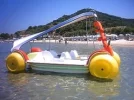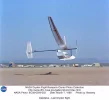Andy offered:aircraft pollution is the worst thing
Here's an article on the following climate change conference in Bali, 07'
« Imogen Heap - Musical - and Technological - Genius
The New Imperialism: Diversity and Cultural Sensitivity »
Carbon Footprint of UN Conference
21st November 2007, 08:09 am
Much of the blame for carbon dioxide emissions gets put on cars. However if you really want to warm the planet fast and you believe the current scientific consensus that CO2 emissions are to blame, then hop on board an international flight. This is the reason why I can’t get past the irony of holding a UN sponsored conference on climate change in one of the most remote places on the planet, about as far from UN headquarters as you can go and still get a tan without drowning.
The distance between New York City and Bali, Indonesia is 10163 miles (16356 km) (8832 nautical miles). The US is sending 60 delegates - so we’ll assume that they are all based at UN headquarters in NYC. We’ll also assume that they aren’t packed in coach and that they are flying Business Class on a non-stop flight that is 80% full.
Here’s a nifty calculator that does all the calculations based on latitude and longitude.
For this single trip, each participant from New York City will use 1,731 kg of fuel, producing 5,282 kg of CO2 with the warming effect of 16,146 kg.
That’s each participant leaving New York City. Multiplying that result by 60, the American delegation alone is responsible for 103,860 kg of fuel, producing 316,920 kg of CO2 with the warming effect of 968,720 kg.
But 10,000 people are expected to attend the conference and so far I’ve been unable to find any type of geographic breakdown. So I’m going to make some assumptions:
4,000 participants from New York - that’s where UN headquarters is.
1,000 from Los Angeles - for press, Hollywood UN groupies, and UN personnel stationed at west coast consulates.
3,000 from Rome - for European NGO, UN and official contingents
1,000 from Hong Kong - that will cover participants and press from Japan, China and SE Asia
1,000 from Delhi - which will cover South Asia, the Middle East and Africa
Origination # of travelers
kg of fuel per traveler total fuel
kg of CO2 per traveler total CO2
kg of CO2 warming effect per traveler total warming effect
New York 4,000 people
1,731 6,924,000 kg
5,282 21,128,000 kg
16,146 64,584,000 kg
Los Angeles 1,000 people
1,450 1,450,000 kg
4,508 4,508,000 kg
13,525 13,525,000 kg
Rome 3,000 people
1,240.00 3,720,000 kg
3,850.00 11,550,000 kg
11,560.00 34,680,000 kg
Hong Kong 1,000 people
404 404,000 kg
1,256 1,256,000 kg
3,769 3,769,000 kg
Delhi 1,000 people
608 608,000 kg
1,889 1,889,000 kg
5,666 5,666,000 kg
Totals:
Fuel used: 13,106,000 kg
CO2 produced: 40,331,000 kg
Warming effect: 122,224,000 kg
I will update this post with better numbers as I find them. However my estimate is that the UN conference in Bali will spew over 40,000 metric tons of CO2 into the atmosphere in air travel alone. This CO2 has the warming effect of just over 122,000 metric tons of CO2.
According to this Wikipedia article, trees planted in the tropics remove 22kg of CO2 from the atmosphere per year. That’s roughly 45 trees needed to remove one metric ton of CO2.
So in order to cover the 40,000 metric tons we would have to plant roughly 2,000,000 trees in the tropics. I am currently working on learning more about these plantings, including species (e.g. Leucaena leucocephala, a Mexican native), size of tree, and the number of trees per hectare - so that I can estimate the area of afforestation it would take to offset this conference. However, I’m very leery of planting non-native species based on my experience with Senna spectabilis, a tree that is so invasive that you can cut one down, take the log and stick it into the ground and before you know it it will sprout and grow. Senna might offset carbon, but Senna forest is a desert in terms of its ability to support wildlife.
UPDATE:
Finding stem density for tropical forests has been tough. The best I’ve found so far is this study on Ugandan forest. They used a 10cm DBH threshold, and found an average density of 479 trees per hectare. Using this figure I calculate that 4,175 hectares (10,317 acres) of trees would need to be planted to offset the carbon produced by the conference. Or just over 1 acre of trees per participant.
Glenn Reynolds has stated, “I’ll believe it’s a crisis when the people who say it’s a crisis start acting like it’s a crisis.” It’s difficult to argue with that sentiment. Imagine a conference to fight illegal drugs being attended by participants who were stoned, or holding a meeting to combat obesity at an all-you-can-eat buffet. Are global warming skeptics the only ones who appreciate the irony here?
Hat tip: The Rosett Report
UPDATE: 12/5/2007
The Seattle Post Intelligencer gives the carbon footprint at 47,000 tons, which is a bit higher than my estimate. However the article quotes Chris Goodall, author of the book “How to Live a Low-Carbon Life,” as saying that the figure is probably closer to 100,000 tons.
Now, why is this on target for this Forum?
1. These "eco-friendly" pilgrims are advancing the next religion...bordering on paganism.
2. They talk the talk...but, as would a good pilgrim...they refuse to walk the walk!
3. Redistribution of wealth is a major goal of this movement....not saving the planet. The folks selling carbon offsets are the same people saying carbon is bad....a self-serving group.
I taught both environmental and wilderness education...I stopped when the newly degreed and recently hired "science' teachers began to radicalize their students with audio tapes and books written by individuals hold up in an apartment in Colorado or a former senator fron TN.
While I'd agree that we should do are best to keep the planet clean, beware of folks touting the sky is falling, while at the same time selling "falling sky" shields.
We can all do our part...and since this Forum is about the Camino...it is a matter of keeping the Way clean, properly disposing of residue of our making and leaving the politics at home, or whatever recycle bin you chose to use.
Buen Camino,
Arn


























